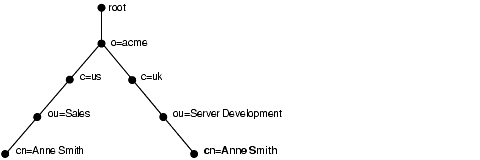10g (9.0.4)
Part Number B12118-01
Home |
Solution Area |
Contents |
Index |
| Oracle® Internet Directory Administrator's Guide 10g (9.0.4) Part Number B12118-01 |
|
Directory Concepts and Architecture, 2 of 15
In an online directory, each collection of information about an object is called an entry. An entry can include, for example, information about an employee, a conference room, an e-commerce partner, or a shared network resource such as a printer.
Each entry in an online directory is uniquely identified by a distinguished name (DN). The distinguished name tells you exactly where the entry resides in the directory hierarchy. This hierarchy is represented by a directory information tree (DIT).
To understand the relation between a distinguished name and a directory information tree, look at Figure 2-1.

The DIT in Figure 2-1 diagrammatically represents entries for two employees of Acme Corporation who are both named Anne Smith. It is structured along geographical and organizational lines. The Anne Smith contained in the left branch works in the Sales division in the United States, while the other works in the Server Development division in the United Kingdom.
The Anne Smith contained in the right branch has the common name (cn) Anne Smith. She works in an organizational unit (ou) named Server Development, in the country (c) of Great Britain (uk), in the organization (o) Acme.
The DN for this "Anne Smith" entry is:
cn=Anne Smith,ou=Server Development,c=uk,o=acme
Note that the conventional format of a distinguished name places the lowest DIT component at the left, then follows it with the next highest component, moving progressively up to the root.
Within a distinguished name, the lowest component is called the relative distinguished name (RDN). For example, in the previous entry for Anne Smith, the RDN is cn=Anne Smith. Similarly, the RDN for the entry immediately above Anne Smith's RDN is ou=Server Development, the RDN for the entry immediately above ou=Server Development is c=uk, and so on. A DN is thus a concatenation of RDNs that reflects parent-child relationships in the DIT. Within the DN, RDNs are separated by commas.
To locate a particular entry within the overall DIT, a client uniquely identifies that entry by using the full DN--not simply the RDN--of that entry. For example, within the global organization in Figure 2-1, to avoid confusion between the two Anne Smiths, you would use each one's full DN. If there are potentially two employees with the same name in the same organizational unit, you could use additional mechanisms--for example, you could identify each employee with a unique number.
To make operations on entries quick and efficient, Oracle Internet Directory uses entry caching. When you enable this feature, Oracle Internet Directory assigns a unique identifier to each entry, then stores a specified number of those identifiers in cache memory. When a user performs an operation on an entry, the directory server looks in the cache for the entry identifier, then retrieves the corresponding entry from the directory. This method enhances Oracle Internet Directory performance, and is especially useful in smaller and medium-sized enterprises.
|
|
 Copyright © 1999, 2003 Oracle Corporation. All Rights Reserved. |
|